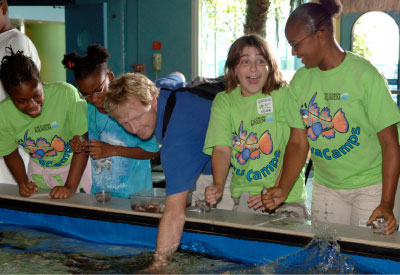 |
||||||||
Behind the Scenes at the Florida Aquarium
Have you ever wondered what it’s like to fix meals for thousands of animals every day or thought about what it takes to clean fish “bowls” containing 500,000 gallons of water — and where the water comes from?
Visitors to the Florida Aquarium can dive in for an up-close look at the inner workings of this world-class aquarium by signing up for a daily behind-the-scenes tour.
One of the first stops is the commissary, where food is stored and prepared according to copious instructions on a white board that identifies who gets what. A typical week’s grocery list might include 100 pounds of smelt, 10 pounds of shrimp, 20 pounds of salmon, and 100 pounds of squid – all restaurant grade and arriving frozen. That’s in addition to 16,000 live mysid shrimp, dozens of boxes of fresh lettuce and kale, and fresh fruit.
The leafy seadragon, which consumes hundreds of dollars worth of live mysid shrimp each week, is the most expensive animal to feed, while birds get the most variety – strawberries, grapes, vegetables, mice and insects.
Altogether, the aquarium’s daily food tab runs about $315, or roughly $115,000 a year, according to Jenn Moffatt, director of husbandry. Beyond the traditional fish and bird chow, the commissary also stocks some unusual fare: frozen mice and white rats for snakes and raptors and live crickets for frogs and birds.
 Photo courtesy Florida Aquarium |
| Campers get a demonstration on how to feed stingrays. |
When it comes to doling out vitamins and medicines, food crews have a few tricks up their sleeves. One particularly effective technique is mixing lettuce and kale in a large blender with fish and clear gelatin dosed with medicines and vitamins. The gelatin “shooters” are then cut up and fed to coral reef animals.
From the commissary, visitors go up to the roof to observe a live feeding and learn more about the aquarium’s vast waterworks and life-support systems. Saltwater is shipped in every six to eight weeks to replace evaporating water in the coral reef tank. A separate filtration system “scrubs” the water in the 500,000-gallon coral reef tank every 70 minutes. And there are rooftop and ground-level quarantine stations to monitor incoming animals and plants for diseases.
At the coral reef tank, a green moray eel, tarpon and puffer fish, and an injured green sea turtle named Flip are among the first to surface for lunch. “They’re called green sea turtles because they eat so much green leafy food that their muscle tissue is actually green,” says biologist Jordan Ward, as he tosses some spinach to Flip. Coral reef fish are fed 35 to 45 pounds of food per day.
Visitors also can peer from above into the freshwater springs, a 12,000-gallon tank that mimics one of Florida’s springs that gush over eight billion gallons of water a day.
Guests can now feed stingrays
For those eager for a hands-on experience, the aquarium now offers guests a chance to feed stingrays and learn more about these creatures, which are related to sharks.
Guests learn everything from what they eat to why the stingray shuffle is so important when visiting Florida beaches. The flattened bodies of stingrays allow them to effectively conceal themselves in their environment. Stingrays do this by agitating the sand and hiding beneath it. Because their eyes are on top of their bodies and their mouths on the undersides, stingrays cannot see their prey, but instead use smell and electro-receptors similar to those of sharks. Visitors can take comfort in knowing that the venomous barbs or stingers have been removed from the tails of the aquarium’s cownose and southern stingrays.
After picking up food at the commissary – chunks of butter fish, herring and clams – guests head over to the 5,000-gallon lobby touch tank to feed the rays. “They’re like little vacuum cleaners of the ocean,” the tour guide explains. Rays have flat, plate-like teeth that allow them to crush clam and crab shells. Participants are instructed to hold the food like a stem of flowers, with the fish exposed from a clenched fist. By placing the food under their bodies as the rays swim by, the animals gently suck up the fish with their mouths.
It’s a hands-on experience visitors won’t soon forget.
| Stingray feeding tours are at 2:30 every day except Sunday and Tuesday. The tour is $20 for non-members and $16 for members. Children must be at least 8 years old and the tour is limited to eight guests. Behind the Scenes tours are conducted daily at 12:30 and cost $10 for members and $12 for non-members. For more information, visit flaquarium.org. |
